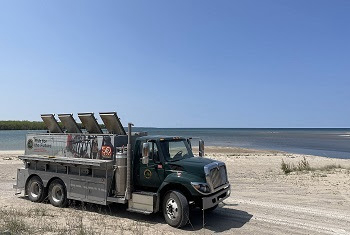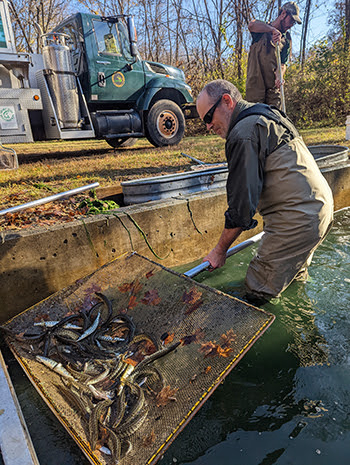DNR sees southern Michigan success in fall walleye stocking

Fall is harvest time in Michigan, and while most may be thinking of picking apples or plucking pumpkins, Michigan Department of Natural Resources fisheries crews are thinking about walleye.Specifically, they’re collecting the last of the walleye fingerlings that are raised in rearing ponds for stocking and getting the fish to where they want them to be.
For the most part, walleye are reared for a short period of time in ponds and stocked as spring fingerlings – most at less than 2 inches in length – in high densities. But fisheries biologists know that fall fingerlings can be stocked at much lower densities and produce better results than spring fingerlings.
Recently, DNR technician supervisor Ed Pearce brought his crew (technicians Mike Wilson and Matt Smith) to the state’s walleye ponds near Belmont in Kent County to get the walleye out of the ponds and into a couple of southern Michigan lakes.
“We have found that if we put in fall fingerlings, their survival is very, very good,” said Jay Wesley, the DNR’s Lake Michigan Basin coordinator. “It’s really the key to stocking walleye in southern Michigan. We’ve done it with fry, but it’s really hit or miss.”
Although walleye are much in demand – anglers love them – most southern Michigan waters are not ideal for the fish, which prefer cooler water than most southern Michigan lakes maintain in the summer.
In addition, most lakes have established fish populations that predate heavily upon the tiny walleye. By stocking fall fingerlings, fisheries managers not only enjoy better fish survival but are also more likely to establish fishable walleye populations.
“If we can get a cool-water hatchery facility, our capacity to raise more fall fingerlings would increase,” Wesley said. “Right now, we’re kind of doing it experimentally, pond by pond, but we need a coordinated effort at one hatchery to really get it going.”
The operation at Belmont consists of three ponds – a fill pond, fed by a natural creek; the walleye pond; and a minnow pond, which is stocked early in the season with fathead minnows that will reproduce and provide forage for the walleye pond.
Members of the club tended the ponds all spring and summer. In spring, they fertilize the ponds to produce the plankton the fry need to survive.
“For six weeks, we put 500 to 600 pounds of fertilizer – a mixture of alfalfa and soy meal – into the ponds to provide the nutrients for the plankton,” said Al Davis, club director. “We started with 100 pounds of minnows in the minnow pond, and we produced more than 400 pounds of minnows this year – and we’ve still got minnows in there.
“We had more than 90 man-hours in just feeding fish and transferring the minnows from the minnow pond to the walleye pond.”
Fall harvest involves lowering the water level to congregate the fish more closely, then installing trap nets to collect them. It takes two days of water-lowering and net-setting to get the bulk of the fish.
Next, the remaining water is drained into what the guys call a “wolf trap” – a concrete and screen box below the pond’s discharge tube – where the remaining fish are entrapped and netted out.
Pond production is highly variable, depending largely on environmental factors over which no one has control. The poor production this spring led to a bonanza of fall fingerlings.
“It has been a good year this year,” Davis said, as he handled nets at the recent fingerling harvest. “In 2010, we had a bunch of fish, but a flood came through and blew the dike. The fish all wound up in the Grand River.
“But since 2009, this pond has produced more than 800,000 walleye fry.”
Raising fingerlings is costly and time-consuming. The club chipped in to help defray the cost of fertilizer and provided the bulk of the labor.
Pearce, who praised the club effusively, said the program would be nearly impossible without the club’s assistance.
“These fall fingerlings are worth their weight in gold,” Pearce said. “We use them in lakes that are full of bluegills; bluegills are good predators, so we put them in at a size that they’re not going to get eaten up.”
Fall fingerlings tend to measure 5 to 7 inches. It’ll take about two years for them to recruit into the fishery, when they become legal targets at 15 inches.
Schoolchildren from two nearby schools attended the first day of the fall fingerling harvest.
Elisabeth Sochacki, who teaches language arts at Assumption School, brought her 38 seventh- and eighth-graders to observe and explore. She turned them loose with dip nets and buckets to collect tadpoles and aquatic insects for the school’s aquaria.
“It’s about writing and research,” she said. “They’ve been out here quite a bit this year, testing water for dissolved oxygen, pH, chlorine and heavy metals. It’s a cool thing for the kids, keeping them engaged.”
Jeremy Karel, the principal at Belmont Elementary, brought his fifth- and sixth-graders out for the day as well as the teachers and some parents.
“It’s giving the kids a chance to get out in nature, and it’s a chance for them to be around adults who care about the environment and are giving back,” Karel said. “And it links up with our science curriculum; this is something they can go back and talk about.”
For his part, Pearce said the fall fingerling harvest is one of his favorite tasks as a fisheries worker.
“This is enjoyable,” Pearce said. “You’re doing your job, and you’re educating kids, too. These are the days we look forward to.”
Get more information on DNR fish stocking at michigan.gov/fishing.





